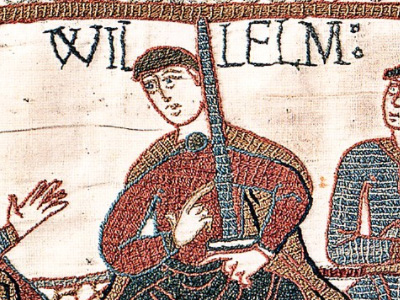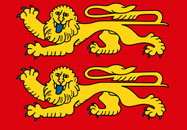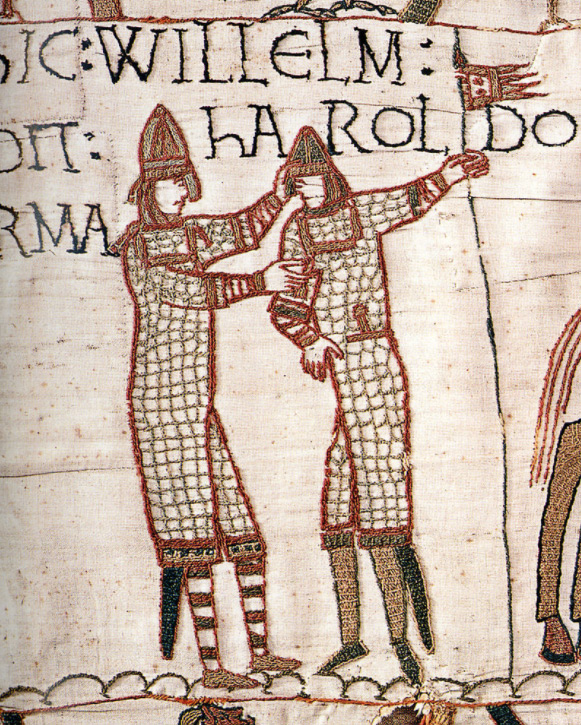William the Conqueror (1028-1087)
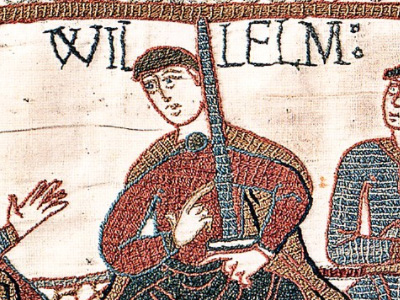
Duke of Normandy
Challenges
William faced several challenges on becoming duke, including his illegitimate birth and his youth: the evidence indicates that he was either seven or eight years old at the time. He enjoyed the support of his great-uncle, Archbishop Robert, as well as the king of France The Kingdom of France is the historiographical name or umbrella term given to various political entities of France in the medieval and early modern period. It was one of the most powerful states in Europe since the High Middle Ages. It was also an early colonial power, with possessions around the world. Colonial conflicts with Great Britain led to the loss of much of its North American holdings by 1763. The Kingdom of France adopted a written constitution in 1791, but the Kingdom was abolished a year later and replaced with the First French Republic., Henry I, enabling him to succeed to his father's duchy. The support given to the exiled English princes in their attempt to return to England
The Kingdom of France is the historiographical name or umbrella term given to various political entities of France in the medieval and early modern period. It was one of the most powerful states in Europe since the High Middle Ages. It was also an early colonial power, with possessions around the world. Colonial conflicts with Great Britain led to the loss of much of its North American holdings by 1763. The Kingdom of France adopted a written constitution in 1791, but the Kingdom was abolished a year later and replaced with the First French Republic., Henry I, enabling him to succeed to his father's duchy. The support given to the exiled English princes in their attempt to return to England The Kingdom of England was a sovereign state on the island of Great Britain from about 927, when it emerged from various Anglo-Saxon kingdoms, until 1 May 1707, when it united with Scotland to form the Kingdom of Great Britain. The Viking invasions of the 9th century upset the balance of power between the English kingdoms, and native Anglo-Saxon life in general. The English lands were unified in the 10th century in a reconquest completed by King Æthelstan in 927. in 1036 shows that the new duke's guardians were attempting to continue his father's policies, but Archbishop Robert's death in March 1037 removed one of William's main supporters, and conditions in Normandy quickly descended into chaos.
The Kingdom of England was a sovereign state on the island of Great Britain from about 927, when it emerged from various Anglo-Saxon kingdoms, until 1 May 1707, when it united with Scotland to form the Kingdom of Great Britain. The Viking invasions of the 9th century upset the balance of power between the English kingdoms, and native Anglo-Saxon life in general. The English lands were unified in the 10th century in a reconquest completed by King Æthelstan in 927. in 1036 shows that the new duke's guardians were attempting to continue his father's policies, but Archbishop Robert's death in March 1037 removed one of William's main supporters, and conditions in Normandy quickly descended into chaos.
The anarchy in the duchy lasted until 1047, and control of the young duke was one of the priorities of those contending for power. At first, Alan of Brittany had custody of the duke, but when Alan died in either late 1039 or October 1040, Gilbert of Brionne took charge of William. Gilbert was killed within months, and another guardian, Turchetil, was also killed around the time of Gilbert's death. Yet another guardian, Osbern, was slain in the early 1040s in William's chamber while the duke slept. It was said that Walter, William's maternal uncle, was occasionally forced to hide the young duke in the houses of peasants, although this story may be an embellishment by Orderic Vitalis. The historian Eleanor Searle speculates that William was raised with the three cousins who later became important in his career – William fitzOsbern, Roger de Beaumont, and Roger of Montgomery. Although many of the Norman nobles engaged in their own private wars and feuds during William's minority, the viscounts still acknowledged the ducal government, and the ecclesiastical hierarchy was supportive of William.
King Henry continued to support the young duke, but in late 1046 opponents of William came together in a rebellion centred in lower Normandy, led by Guy of Burgundy with support from Nigel, Viscount of the Cotentin, and Ranulf, Viscount of the Bessin. According to stories that may have legendary elements, an attempt was made to seize William at Valognes, but he escaped under cover of darkness, seeking refuge with King Henry. In early 1047 Henry and William returned to Normandy and were victorious at the Battle of Val-ès-Dunes near Caen, although few details of the actual fighting are recorded. William of Poitiers claimed that the battle was won mainly through William's efforts, but earlier accounts claim that King Henry's men and leadership also played an important part. William assumed power in Normandy, and shortly after the battle promulgated the Truce of God throughout his duchy, in an effort to limit warfare and violence by restricting the days of the year on which fighting was permitted. Although the Battle of Val-ès-Dunes marked a turning point in William's control of the duchy, it was not the end of his struggle to gain the upper hand over the nobility. The period from 1047 to 1054 saw almost continuous warfare, with lesser crises continuing until 1060.
Consolidation of Power
William's next efforts were against Guy of Burgundy, who retreated to his castle at Brionne, which William besieged. After a long effort, the duke succeeded in exiling Guy in 1050. To address the growing power of the Count of Anjou, Geoffrey Martel, William joined with King Henry in a campaign against him, the last known cooperation between the two. They succeeded in capturing an Angevin fortress, but accomplished little else. Geoffrey attempted to expand his authority into the county of Maine, especially after the death of Hugh IV of Maine in 1051. Central to the control of Maine were the holdings of the Bellême family, who held Bellême on the border of Maine and Normandy, as well as the fortresses at Alençon and Domfort. Bellême's overlord was the king of France, but Domfort was under the overlordship of Geoffrey Martel and Duke William was Alençon's overlord. The Bellême family, whose lands were quite strategically placed between their three different overlords, were able to play each of them against the other and secure virtual independence for themselves.
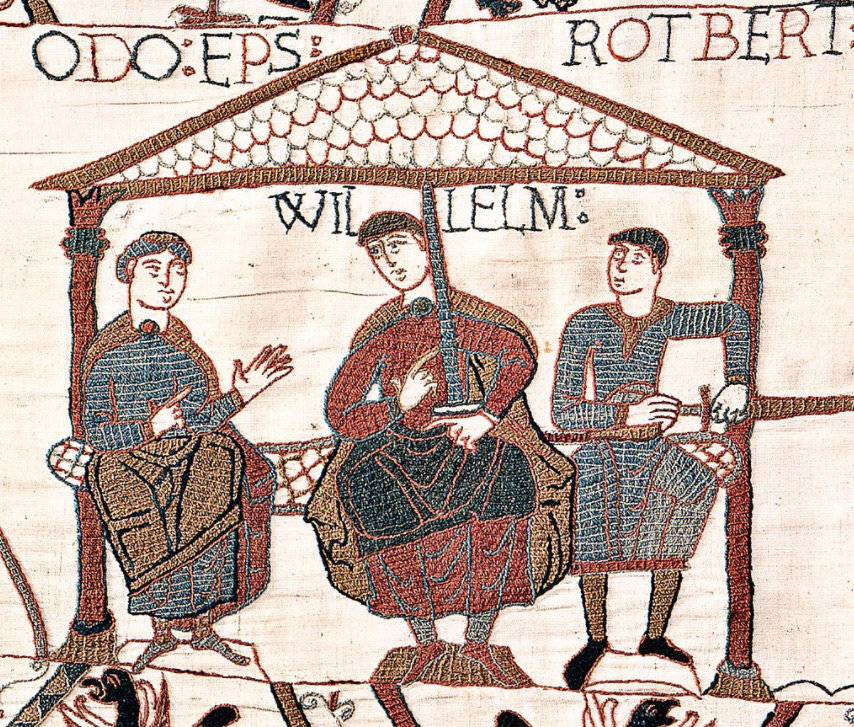
Image from the Bayeux Tapestry showing William with his half-brothers. William is in the centre, Odo is on the left with empty hands, and Robert is on the right with a sword in his hand.
On the death of Hugh of Maine, Geoffrey Martel occupied Maine in a move contested by William and King Henry; eventually they succeeded in driving Geoffrey from the county, and in the process, William was able to secure the Bellême family strongholds at Alençon and Domfort for himself. He was thus able to assert his overlordship over the Bellême family and compel them to act consistently in Norman interests. But in 1052 the king and Geoffrey Martel made common cause against William at the same time as some Norman nobles began to contest William's increasing power. Henry's about-face was probably motivated by a desire to retain dominance over Normandy, which was now threatened by William's growing mastery of his duchy. William was engaged in military actions against his own nobles throughout 1053, as well as with the new Archbishop of Rouen, Mauger. In February 1054 the king and the Norman rebels launched a double invasion of the duchy. Henry led the main thrust through the county of Évreux, while the other wing, under the French king's brother Odo, invaded eastern Normandy.
William met the invasion by dividing his forces into two groups. The first, which he led, faced Henry. The second, which included some who became William's firm supporters, such as Robert, Count of Eu, Walter Giffard, Roger of Mortemer, and William de Warenne, faced the other invading force. This second force defeated the invaders at the Battle of Mortemer. In addition to ending both invasions, the battle allowed the duke's ecclesiastical supporters to depose Mauger from the archbishopric of Rouen. Mortemer thus marked another turning point in William's growing control of the duchy, although his conflict with the French king and the Count of Anjou continued until 1060. Henry and Geoffrey led another invasion of Normandy in 1057 but were defeated by William at the Battle of Varaville. This was the last invasion of Normandy during William's lifetime. In 1058, William invaded the County of Dreux and took Tillières-sur-Avre and Thimert. Henry attempted to dislodge William, but the Siege of Thimert dragged on for two years until Henry's death. The deaths of Count Geoffrey and the king in 1060 cemented the shift in the balance of power towards William.
One factor in William's favour was his marriage to Matilda of Flanders, the daughter of Count Baldwin V of Flanders. The union was arranged in 1049, but Pope Leo IX forbade the marriage at the Council of Rheims in October 1049. The marriage nevertheless went ahead some time in the early 1050s, possibly unsanctioned by the pope. According to a late source not generally considered to be reliable, papal sanction was not secured until 1059, but as papal-Norman relations in the 1050s were generally good, and Norman clergy were able to visit Rome in 1050 without incident, it was probably secured earlier. Papal sanction of the marriage appears to have required the founding of two monasteries in Caen – one by William and one by Matilda. The marriage was important in bolstering William's status, as Flanders was one of the more powerful French territories, with ties to the French royal house and to the German emperors. Contemporary writers considered the marriage, which produced four sons and five or six daughters, to be a success.
HISTORY
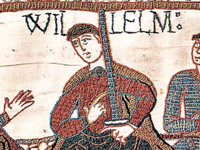
RESOURCES
This article uses material from the Wikipedia article "William the Conqueror (1028-1087)", which is released under the Creative Commons Attribution-Share-Alike License 3.0.
© Stories Preschool. All Rights Reserved.
